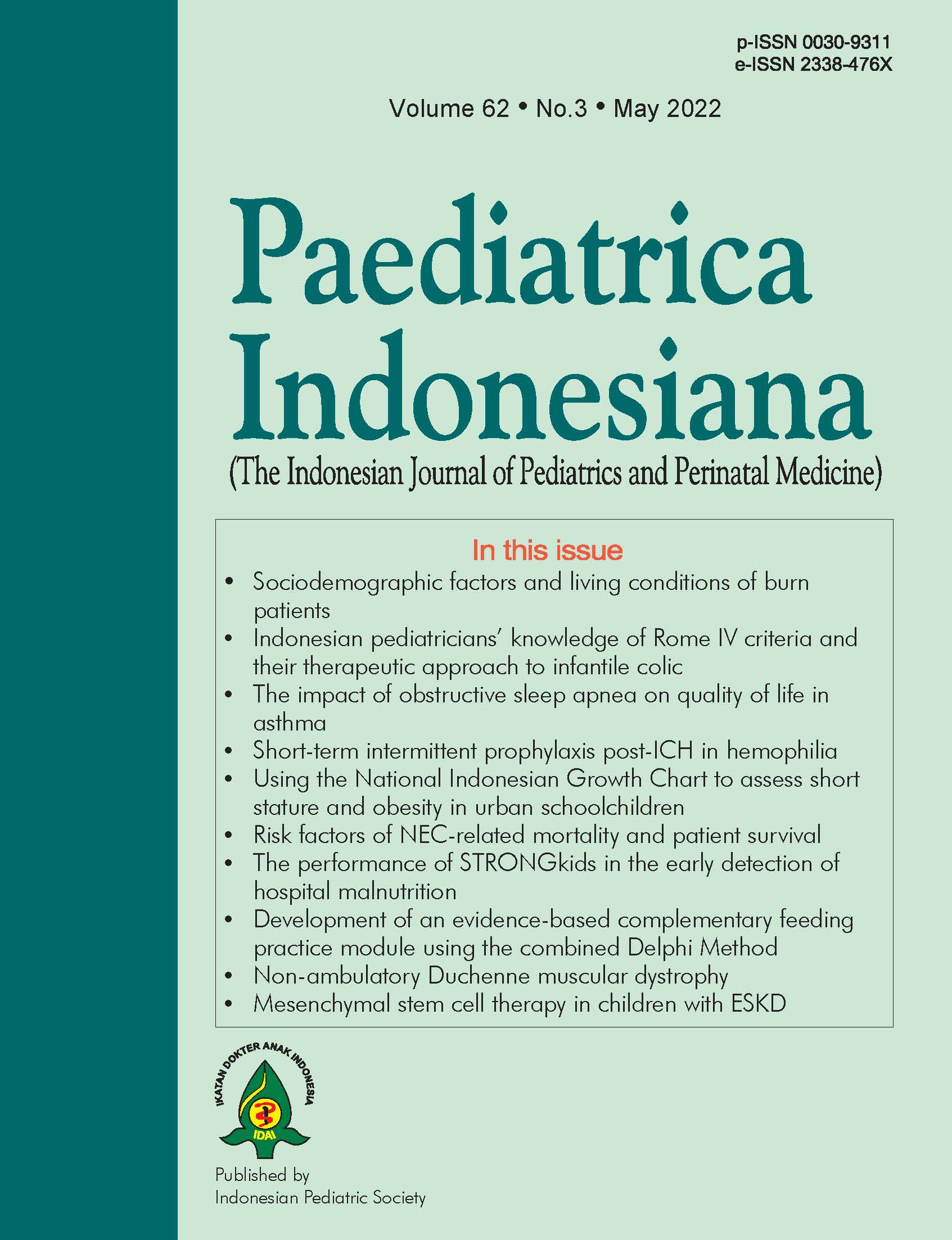Sociodemographic factors and living conditions of pediatric burn patients
DOI:
https://doi.org/10.14238/pi62.3.2022.149-55Keywords:
burns, living conditions, pediatric patients, refugees, sociodemographic factorsAbstract
Background Children are the age group most vulnerable to burn injuries. Socioeconomic factors and the living environment, including the poor living conditions faced by refugees, may contribute to the occurrence of burns.
Objectives To compare living conditions and socioeconomic status potentially contributing to burn injury, characteristics, access to medical treatment, and integrated preventive measures between children of Turkish families and Syrian refugees with burn injuries.
Methods In this cross-sectional study, we recorded demographic and epidemiological features, mechanism of burn injury, as well as living- and socioeconomic conditions from interviews with parents of children hospitalized in the Burn Center of the University of Health Sciences Adana City Training and Research Hospital, Adana, Turkey. We classified patients into Turkish (host country) and Syrian (refugee) children.
Results We studied 42 Turkish and 31 Syrian children with burn injuries. The most common heat source was a stove (93.2%) and the most common place of the accident was the kitchen (45.2%). Maternal education (P=0.022), house ownership (P<0.001), number of rooms in the house (P=0.001), number of household members (P=0.007), number of persons per room (P<0.001), and place of heat source (P=0.009) differed significantly between Turkish and Syrian patients. Mean number of household members was 5.38 persons (SD 1.0) and 6.81 persons (SD 0.9) in Turkish and Syrian patients, respectively (P=0.007).
Conclusion Low socioeconomic status with overcrowded living conditions is prominent in both groups. Burns are likely to occur in the kitchen and incited by a stove. Preventive strategies are needed to educate families on the importance of simple safety measures in the house.
References
2. Al-Hajj S, Pike I, Oneissi A, Zheng A, Abu-Sittah G. Pediatric burns among refugee communities in Lebanon: evidence to inform policies and programs. J Burn Care Res. 2019;40:769-75. DOI: https://doi.org/10.1093/jbcr/irz080.
3. Dhopte A, Tiwari VK, Patel P, Bamal R. Epidemiology of pediatric burns and future prevention strategies—a study of 475 patients from a high-volume burn center in North India. Burns Trauma. 2017;5:1. DOI: https://doi.org/10.1186/s41038-016-0067-3.
4. Forjuoh SN. Burns in low- and middle-income countries: a review of available literature on descriptive epidemiology, risk factors, treatment, and prevention. Burns. 2006;32:529–37. DOI: 10.1016/j.burns.2006.04.002.
5. Othman N, Kendrick D. Epidemiology of burn injuries in the East Mediterranean Region: a systematic review. BMC Public Health. 2010;10:83.
6. Bilgen F, Ural A, Bekerecioglu M. Evaluation of Syrian patients treated in our clinic. KSU Med J. 2019;14:6-9. DOI: https://doi.org/10.17517/ksutfd.458812.
7. Sarsu SB, Budeyri A. Mortality risk factors in war-related pediatric burns: a comparative study among two distinct populations. Burns. 2018;44:1210–27. DOI: https://doi.org/10.1016/j.burns.2018.02.014.
8. UNHCR. Global trends in forced displacement. 2017. [cited 2020 December 20]; Available from: https://www.unhcr.org/statistics/unhcrstats/5b27be547/unhcr-global-trends-2017.html.
9. Kandemir H, Karatas H, Ceri V, Solmaz F, Kandemir SB, Solmaz A. Prevalence of war-related adverse events, depression and anxiety among Syrian refugee children settled in Turkey. Eur Child Adolesc Psychiatry 2018;27:1513–7. DOI: https://doi.org/10.1007/s00787-018-1178-0.
10. Gungor A, Catak AI, Cakir BC, Akman AO, Karagol C, Koksal T, et al. Evaluation of Syrian refugees who received inpatient treatment in a tertiary pediatric hospital in Turkey between January 2016 and August 2017. Int Health. 2018;10:371–5. DOI: https://doi.org/10.1093/inthealth/ihy034.
11. Saleh A, Aydin S, Kocak O. A comparative study of Syrian refugees in Turkey, Lebanon, and Jordan: healthcare access and delivery. OPUS–Int J Soc Res. 2018;8;448-64. DOI: https://doi.org/10.26466/opus.376351.
12. Smolle C, Cambiaso-Daniel J, Forbes AA, Wurzer P, Hundeshagen G, Branski LK, et al. Recent trends in burn epidemiology worldwide: a systematic review. Burns. 2017;43:249–57. DOI: https://doi.org/10.1016/j.burns.2016.08.013.
13. Lee CJ, Mahendraraj K, Houng A, Marano M, Petrone S, Lee R, et al. Pediatric burns: a single institution retrospective review of incidence, etiology, and outcomes in 2273 burn patients (1995-2013). J Burn Care Res. 2016;37:e579–85. DOI: https://doi.org/10.1097/BCR.0000000000000362.
14. Alghothani N, Alghothani Y, Atassi B. Evaluation of a short-term medical mission to Syrian refugee camps in Turkey. Avicenna J Med. 2012;2:84-8. DOI: https://doi.org/10.4103/2231-0770.110738.
15. Eurostat. People in the EU - statistics on household and family structures. 2018. [cited 2020 December 20]. Available from: https://ec.europa.eu/eurostat/statistics-explained/index.php?title=Archive:People_in_the_EU_-_statistics_on_household_and_family_structures.
16. Sozen I, Guldogan CE, Yast? AC. Etiology of childhood burns and parental awareness in Turkey. Ulus Cerrahi Derg. 2015;32:168–72. DOI: https://doi.org/10.5152/UCD.2016.3285.
17. Atiyeh BS, Gunn SWA. Refugee camps, fire disasters and burn injuries. Ann Burns Fire Disasters. 2017;30:214–7. PMID: 29849526.
18. Kazerooni Y, Gyedu A, Burnham G, Nwomeh B, Charles A, Mishra B, et al. Fires in refugee and displaced persons settlements: the current situation and opportunities to improve fire prevention and control. Burns. 2016;42:1036–46. DOI: https://doi.org/10.1016/j.burns.2015.11.008.
19. Oseni OG, Olamoyegun KD, Olaitan PB. Paediatric burn epidemiology as a basis for developing a burn prevention program. Ann Burns Fire Disasters. 2017;30:247-9. PMID: 29983674.
Downloads
Published
How to Cite
Issue
Section
License
Authors who publish with this journal agree to the following terms:
Authors retain copyright and grant the journal right of first publication with the work simultaneously licensed under a Creative Commons Attribution License that allows others to share the work with an acknowledgement of the work's authorship and initial publication in this journal.
Authors are able to enter into separate, additional contractual arrangements for the non-exclusive distribution of the journal's published version of the work (e.g., post it to an institutional repository or publish it in a book), with an acknowledgement of its initial publication in this journal.
Accepted 2022-04-13
Published 2022-04-13


















